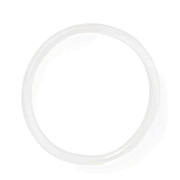For most people, the risk of blood clots is low when they use the combination pill, the ring, and the patch. But smoking increases this risk. If you are over 35 and smoke 15 or more cigarettes a day, the combination pill, patch, and ring are not safe options for you. If you’re over 35 and you smoke less than 15 cigarettes a day, talk to your provider about whether these birth control methods are safe options for you.
Birth control ring

I’m a smoker. What birth control options are best for me?
What are good methods for women with high blood pressure?
If you have high blood pressure, methods with estrogen—the combination pill, the ring, and the patch—may make your blood pressure even higher, increasing the risk of a heart attack or stroke. Fortunately, there are lots of highly effective birth control options that are safe and estrogen-free like the progestin-only pill, all types of IUD, the implant, and the shot. Talk to a health care provider about your blood pressure and what birth control is an option for you.
Anything I can do so that my partner doesn't feel the ring during sex?
If you are using the monthly ring and decide to take it out during sex during the three weeks (21 days) that you have the ring in, make sure to put it back in as soon as possible. If it’s out for more than 48 hours, you’re at risk of getting pregnant, so you’ll need to use a backup form of birth control for 7 days after putting the ring back in. If you leave the NuvaRing out for more than 48 hours during the third week of a cycle, put it back in right away. On the day when you would normally have taken the ring out (day 22 of the cycle, where day 1 is the day you put it in), take it out and put a new one in, skipping your ring-free week. If you don’t put a new one in on that day, you’ll need to use a backup form of birth control anytime you have sex in the first 7 days after you put your new ring in.
Both the annual ring (Annovera) and the monthly ring (NuvaRing) are designed to stay in during sex without your partner feeling them. If your partner feels the ring during sex, you can try to reposition it deeper into your vagina so they don’t feel it (it can’t get lost in there. Promise).
For it to be effective at preventing pregnancy, the ring needs to be in your vagina almost all the time, especially if you are using the annual ring (Annovera). If the annual ring comes out during the three weeks (21 days) that you have it in, make sure to put it back in right away. If Annovera is out of your vagina for more than two hours total during those 21 days, you will need to use a backup method of birth control for seven days after putting it back in.
If you are using the monthly ring and decide to take it out during sex during the three weeks (21 days) that you have the ring in, make sure to put it back in as soon as possible. If it’s out for more than 48 hours, you’re at risk of getting pregnant, so you’ll need to use a backup form of birth control for 7 days after putting the ring back in. If you leave the NuvaRing out for more than 48 hours during the third week of a cycle, put it back in right away. On the day when you would normally have taken the ring out (day 22 of the cycle, where day 1 is the day you put it in), take it out and put a new one in, skipping your ring-free week. If you don’t put a new one in on that day, you’ll need to use a backup form of birth control anytime you have sex in the first 7 days after you put your new ring in.
Want to learn more?
Will the ring dissolve inside me?
Nope. It won’t. And it won’t get lost inside either.
Want to learn more?
How effective is the ring at preventing pregnancy?
Depending on the type of ring you use and how consistently you change the ring on time, it can be very effective at preventing pregnancy. With perfect use, it’s 97- 99% effective. The way it’s typically used, though, it’s around 93% effective.
In other words:
Of those who use the monthly ring exactly as directed for a whole year, fewer than 1 in 100 will get pregnant when they don’t want to during the first year of using the ring. If you are using the yearly birth control ring perfectly, it’s slightly less effective—97%.
Of those who do not use the monthly ring exactly as directed, 7 in 100 will get pregnant when they don’t want to during the first year of using the ring. For the yearly ring, we don’t have enough data to know the difference between perfect and typical use rates.
Want to learn more?
How much does the ring cost?
If you have health insurance—whether it’s through your parents, school, job, the Affordable Care Act (ACA) marketplace, or Medicaid—chances are good that you’ll be able to get the ring with no out-of-pocket cost.
If you don’t have health insurance or have a plan that doesn’t cover birth control, it’s true that the cost of each ring can be high. If that isn’t an option for you, the manufacturers of the rings—both the monthly and annual—offer discounts. You can also check with the family planning clinics around you and find out if they offer discounts or payment plans for the ring.
Want to learn more?
If I'm using another method of birth control, do I still have to use condoms?
Depends on if you need protection from sexually transmitted infections (STIs). No method of birth control other than condoms or internal condoms protects you from STIs. Using a condom with another form of birth control is called dual protection since you’re protecting yourself against both pregnancy and STIs.
Does birth control work the minute I get it?
It depends on the method. Some forms of birth control including the pill, patch, ring, shot, and implant are not effective immediately after you start using them, but most IUDs are (and so are methods that you only use when you have sex, like a condom). To be sure, check with a health care provider before having sex without another method of birth control.
Can I keep the ring in all the time and not get my period?
Yes, you can use the ring to skip your period. Just change the ring every four weeks without taking a 1-week break. You’ll just take the old one out and put the new one in on the same day.
Want to learn more?
Can I use tampons or a menstrual cup with the ring?
Tampons and menstrual cups do not interfere with the ring’s effectiveness. If your ring is in when you remove your tampon or cup, you might pull it out a bit, which might be annoying if it happens a lot.
When inserting your tampon or cup, make sure that your ring is all the way in first (it works as birth control in any position in your vagina), and then position the tampon or cup afterwards. If you do end up pulling the ring out, you can rinse it in cool water and re-insert it.
Want to learn more?
I heard that hormone-filled pee is killing our fish and harming the environment. Is taking hormonal birth control bad for our water?
The simple answer is: yes, hormones in birth control are getting into the environment through pee. But—and this is a big but—it is small compared to other sources of estrogen. Current research finds that the contribution of EE2 (the primary active ingredient in the pill, ring, and patch) to the total amount of estrogen in our waterways is small. Bigger—much bigger—sources of estrogen in the environment come from industrial and manufacturing processes, agricultural fertilizers and pesticides, the drugs we give livestock. and the waste and runoff produced by these sources. Avoiding birth control with estrogen hormones will not eliminate the environmental impacts of estrogenic compounds.
Is it a problem if I'm getting vaginal discharge from the ring?
Some vaginal discharge is normal. The extra discharge you are experiencing from using the ring is also probably normal. After a couple of cycles, this discharge may go back to normal.
Also, the ring may protect you from a bacterial infection that can occur in the vagina called bacterial vaginosis (BV).
If you’re concerned that the vaginal discharge that you’re experiencing may be caused by an infection, visit a health care provider.
Want to learn more?

Heat up your weekends with our best sex tips and so much more.